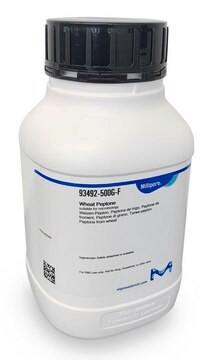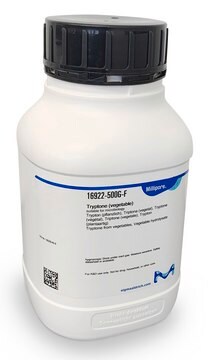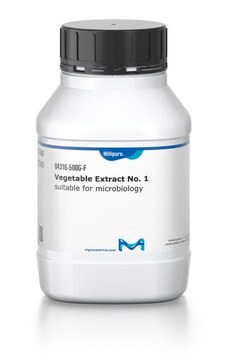About This Item
Polecane produkty
pochodzenie biologiczne
rabbit
Poziom jakości
białko sprzężone
unconjugated
forma przeciwciała
purified antibody
serum
rodzaj przeciwciała
primary antibodies
klon
polyclonal
masa cząsteczkowa
calculated mol wt 67.57 and 48.74 kDa
observed mol wt ~62 and 100 kDa
oczyszczone przez
(Unpurified)
reaktywność gatunkowa
human
reaktywność gatunkowa (przewidywana na podstawie homologii)
rat, mouse
opakowanie
antibody small pack of 100 μL
metody
ChIP: suitable
western blot: suitable
izotyp
IgG
sekwencja epitopowa
C-terminal
numer dostępu Protein ID
numer dostępu UniProt
Warunki transportu
dry ice
docelowa modyfikacja potranslacyjna
unmodified
informacje o genach
human ... runx1t1> RUNX1T1(862)
Opis ogólny
Specyficzność
Immunogen
Zastosowanie
Oceniane metodą Western Blotting w komórkach Kasumi-1; t(8;21) wyrażających AML1-ETO.
Analiza Western Blotting: Rozcieńczenie 1:1000 tego przeciwciała wykryło AML1-ETO w komórkach Kasumi-1; t(8;21) wyrażających AML1-ETO.
Testowane aplikacje
Analiza immunoprecypitacji: Reprezentatywna partia immunoprecypitowana AML1-ETO w komórkach Kasumi-1; t(8;21) wyrażających AML1-ETO (dzięki uprzejmości dr Jinsong Zhang @ Saint Louis University).
Immunoprecypitacja chromatyny (ChIP): Reprezentatywna partia wykryła AML1-ETO w komórkach Kasumi-1; t(8;21) wyrażających AML1-ETO (dzięki uprzejmości dr Jinsong Zhang @ Saint Louis University).
ChIP-seq: Reprezentatywna partia wykryła AML1-ETO w aplikacjach ChIP-seq (Guo, Chun., et. al. (2020). J Biol Chem. 295(13); 4212-4223.
Analiza immunoprecypitacji chromatyny (ChIP): Reprezentatywna partia wykryła AML1-ETO w aplikacjach immunoprecypitacji chromatyny (Guo, Chun., et. al. (2020). J Biol Chem. 295(13):4212-4223; Steinauer, Nickolas., et. al. (2019). Blood Adv. 3(9): 1379-1393).
Uwaga: Rzeczywiste optymalne rozcieńczenia robocze muszą być określone przez użytkownika końcowego jako próbki, a warunki eksperymentalne mogą się różnić w zależności od użytkownika końcowego.
Postać fizyczna
Przechowywanie i stabilność
Inne uwagi
Oświadczenie o zrzeczeniu się odpowiedzialności
Nie możesz znaleźć właściwego produktu?
Wypróbuj nasz Narzędzie selektora produktów.
Kod klasy składowania
10 - Combustible liquids
Klasa zagrożenia wodnego (WGK)
WGK 1
Temperatura zapłonu (°F)
Not applicable
Temperatura zapłonu (°C)
Not applicable
Certyfikaty analizy (CoA)
Poszukaj Certyfikaty analizy (CoA), wpisując numer partii/serii produktów. Numery serii i partii można znaleźć na etykiecie produktu po słowach „seria” lub „partia”.
Masz już ten produkt?
Dokumenty związane z niedawno zakupionymi produktami zostały zamieszczone w Bibliotece dokumentów.
Nasz zespół naukowców ma doświadczenie we wszystkich obszarach badań, w tym w naukach przyrodniczych, materiałoznawstwie, syntezie chemicznej, chromatografii, analityce i wielu innych dziedzinach.
Skontaktuj się z zespołem ds. pomocy technicznej





